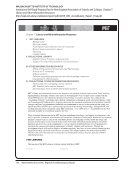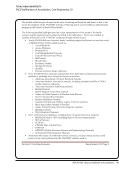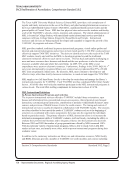SPEC Kit 330: Library Contribution to Accreditation · 109
Brigham Young University
Northwest Commission on Colleges and Universities (NWCCU). Library and Information Resources 5
Facilities for Collections
When Lee and Hunter library facilities were renovated, one goal was to significantly
expand shelving space for print materials. To help achieve this goal, compact shelving was
installed in the Periodicals Room, Special Collections, and Government
Information areas. The Lee Library houses over 98 miles of shelving with a capacity of over 5
million volumes. The Hunter Library has 12.5 miles of shelving and sufficient space to store
over 500,000 books and journals.
Shelving in both libraries is secured to the floor in order to limit damage and protect life
in the event of an earthquake. Standard security and book theft protection technology is installed
in both libraries, and the Lee Library also has a sophisticated card access and video surveillance
system that guards Special Collections and other sensitive areas. The 1999 building addition has
environmental controls that protect collections by maintaining appropriate temperature and
relative humidity.
A space audit conducted in early 2005 revealed that the Lee Library will fill its shelf
capacity by 2012 (RE 5.5). The periodicals section, however, is already in crisis mode, reaching
capacity during 2005. The Hunter Law Library has growth capacity through 2017. Several
strategies are being pursued to address the situation, including remote storage of journal titles
available electronically and investigation of a remote, high-density storage facility for seldom-
used materials. It seems likely that such a facility would be shared with members of either the
Consortium of Church Libraries and Archives or the Utah Academic Library Consortium.
Professional Associations and Consortia
Collaborating with other libraries through state, regional, national, and international
associations is a critical strategy for both the Lee and Hunter Libraries. Among the many
associations the libraries participate in are the American Association of Law Libraries (AALL),
Association of Research Libraries (ARL), Consortium of Church Libraries and Archives
(CCLA), Desert States Law Library Consortium, Greater Western Library Alliance (GWLA),
and the Utah Academic Library Consortium (UALC) (see RE 5.11 for the complete list).
Membership in these groups has resulted in improved services to students and better access to
information through interlibrary loans, cooperative database licensing, and collaborative
digitization. Additionally, consortia participation has fostered cooperative purchase agreements
that enable the libraries to better leverage collection budgets and, in a number of cases, lower
expenditures. These efforts supplement fundamental library programs by expanding access to
scholarly information while at the same time minimizing costs.
Summary
Strengths
“Library as Place” consistently receives the highest ratings in LibQUAL+ studies.
Intensive use seems to evidence student and faculty satisfaction with library facilities.
Brigham Young University
Northwest Commission on Colleges and Universities (NWCCU). Library and Information Resources 5
Facilities for Collections
When Lee and Hunter library facilities were renovated, one goal was to significantly
expand shelving space for print materials. To help achieve this goal, compact shelving was
installed in the Periodicals Room, Special Collections, and Government
Information areas. The Lee Library houses over 98 miles of shelving with a capacity of over 5
million volumes. The Hunter Library has 12.5 miles of shelving and sufficient space to store
over 500,000 books and journals.
Shelving in both libraries is secured to the floor in order to limit damage and protect life
in the event of an earthquake. Standard security and book theft protection technology is installed
in both libraries, and the Lee Library also has a sophisticated card access and video surveillance
system that guards Special Collections and other sensitive areas. The 1999 building addition has
environmental controls that protect collections by maintaining appropriate temperature and
relative humidity.
A space audit conducted in early 2005 revealed that the Lee Library will fill its shelf
capacity by 2012 (RE 5.5). The periodicals section, however, is already in crisis mode, reaching
capacity during 2005. The Hunter Law Library has growth capacity through 2017. Several
strategies are being pursued to address the situation, including remote storage of journal titles
available electronically and investigation of a remote, high-density storage facility for seldom-
used materials. It seems likely that such a facility would be shared with members of either the
Consortium of Church Libraries and Archives or the Utah Academic Library Consortium.
Professional Associations and Consortia
Collaborating with other libraries through state, regional, national, and international
associations is a critical strategy for both the Lee and Hunter Libraries. Among the many
associations the libraries participate in are the American Association of Law Libraries (AALL),
Association of Research Libraries (ARL), Consortium of Church Libraries and Archives
(CCLA), Desert States Law Library Consortium, Greater Western Library Alliance (GWLA),
and the Utah Academic Library Consortium (UALC) (see RE 5.11 for the complete list).
Membership in these groups has resulted in improved services to students and better access to
information through interlibrary loans, cooperative database licensing, and collaborative
digitization. Additionally, consortia participation has fostered cooperative purchase agreements
that enable the libraries to better leverage collection budgets and, in a number of cases, lower
expenditures. These efforts supplement fundamental library programs by expanding access to
scholarly information while at the same time minimizing costs.
Summary
Strengths
“Library as Place” consistently receives the highest ratings in LibQUAL+ studies.
Intensive use seems to evidence student and faculty satisfaction with library facilities.
























































































































































































